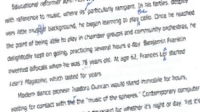Jargon in Catalogs or Online: Three
Reader-Friendly Solutions
by Marcia Yudkin
Someone was half-asleep
while producing the Lands' End clothing
catalog I received not too long ago. The
attractive cover shows a pretty woman
picking oranges and the headline,
"Introducing Sun.Life: The most comfortable
UPF clothing under the sun." If someone
doesn't know what the acronym "UPF" stands
for or what it does, there's not one clue on
the cover to guide them.
On page 9, the text for
this product includes the bullet point "UPF
30 protection without the high price tag,"
again without any explanation. Page 5 has a
bullet point "UPF 50 protection," equally
explanation-free. Although Page 7 explains
what "UPF" stands for, why it's beneficial
and how to understand the numbers, nothing
sends foggy readers there so they'll be able
to interpret UPF numbers as intended.
 |
Improve Your
Proofreading
Quick online course teaches how to
catch pesky typos. Whether you check
writing on screen or on paper, learn the
stakes for error-ridden copy, the five
best proofreading methods and the tools
you can or shouldn't use to identify
errors. Includes practice tests and
answers.
Proofreading Hacks course. |
I saw the same willingness
to baffle some Lands' End readers in shoe
descriptions that talk about an
"antimicrobial lining" or an "EVA footbed"
with no context to clue in someone who
hadn't seen those terms before. Expecting
catalog readers to have the patience to hunt
down a hidden or absent key to product
jargon is both foolish and unnecessary.
Catalog shoppers who
encounter product terms they don't
understand miss the intended point and do
not buy. Manufacturers and retailers always
estimate that way more members of their
target market know their terminology than
actually do. You must, must, must help
readers along!
Here are three techniques
copywriters and catalog designers can use to
help less knowledgeable readers "get it" -
and remind those who are hazy on the terms
so they can follow along with understanding.
1. Include a parenthetical
gloss. The easiest way to explain something
- and less obtrusively than you might expect
- is to provide a definition that is set off
from the main flow of the prose. Use
parentheses, a pair of dashes or a pair of
commas to clarify a term for those who don't
know it without annoying those who do. For
example:
UPF (Ultraviolet
Protection Factor)
UPF - which signifies sunscreen power -
UPF, an indicator of protection against
the harmful rays of the sun,
|
Learn From the
Masters of Straight-Talk Copywriting
In 2013 and 2014, Marcia Yudkin
convened the most articulate and
experienced practitioners of no-hype
copywriting for an exchange of ideas
on writing copy that persuades
without excessive showmanship or
stretching the truth.
Presenters included Peter Bowerman, Nick
Usborne, Shel Horowitz, Karon Thackston
and others.
Order the
recordings from this telesummit. |
2. Provide context.
Surround the jargon with hints, synonyms and
alternative ways of expressing the benefit of
the technology so the smart reader picks up the
meaning without encountering a formal
definition. Some examples:
-
The antimicrobial lining -
say goodbye to foot stink! - stays cushy and
cool all summer.
-
Their padded EVA insoles
add more bounce to your stride.
-
Its UPF 50 cotton gives
you the best sunburn protection you can get
in a T-shirt.
3. Present a primer or
glossary. Add a sidebar (boxed text), an
asterisk with an explanatory footnote or a
formal, full explanation on one page of the
catalog to which you refer readers on every
other page where the jargon appears.
|
Write Product Descriptions That Sizzle and Sell
"73 Ways To Describe a Widget is an absolute goldmine crammed full of really useful information. As a copywriter, you can now hit precisely the right tone or emotion, eliminate every objection, knock out the competition, and produce an massive abundance of sales that just wouldn't have been possible beforehand. Grab this and watch your response rates and income go through the roof." - Steve King, Copywriter, England.
Catalog
copywriting made easy. |
Like all the testimonials on this site, the customer comments on this page were provided without compensation, incentives or rewards.
If jargon appears on only one
or two pages of a catalog, you have the greatest
degree of choice and flexibility in how to clue
in the reader. Resist the temptation to assume
that providing a parenthetical explanation,
context or definitions on one page only solves
the problem, because catalog shoppers do not
necessarily read pages in a certain order or pay
attention to what's on other pages than the one
that caught their interest first.
Online, you have the
convenience of being able to insert a hyperlink
to the definition of any jargon on a separate
page, perhaps in a glossary. The hyperlink
can also trigger a popup or tiny window
containing the definition.
Test your solutions by giving
a mockup of the catalog or web page to readers
who may not know the jargon. Ask them to start
anywhere and point out anything they do not
understand. No questions? Great. Above all, keep
in mind that whatever you are writing, clarity
must always trump cleverness.
Copyright 2016 Marcia Yudkin.
All rights reserved.
Hire
Marcia Yudkin to write or rewrite sales letters,
brochures, web sites, flyers, press releases or
other marketing materials.
Learn
to become a well-paid copywriter/marketing
consultant.
Online Courses That May Interest You
The Sales Letter Makeover Course
The Press Release Makeover Course
The Mighty Postcard Marketing Course
Create a Practical Marketing Plan
Marketing for Introverts |





